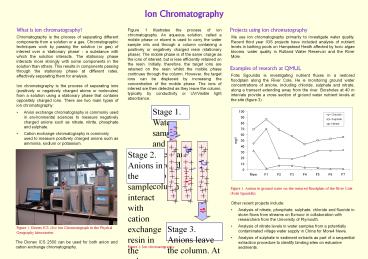Ion Chromatography - PowerPoint PPT Presentation
1 / 1
Title:
Ion Chromatography
Description:
Anion exchange chromatography is commonly used in environmental sciences to ... The blue' anion interacts more strongly with the column and passes through ... – PowerPoint PPT presentation
Number of Views:4381
Avg rating:3.0/5.0
Title: Ion Chromatography
1
Ion Chromatography
Projects using ion chromatography
What is ion chromatography?
Figure 1 illustrates the process of ion
chromatography. An aqueous solution, called a
mobile phase or eluent is used to carry the water
sample into and through a column containing a
positively or negatively charged resin
(stationary phase). The mobile phase is of the
same charge as the ions of interest, but is less
efficiently retained on the resin. Initially,
therefore, the target ions are retained on the
resin whilst the mobile phase continues through
the column. However, the target ions can be
displaced by increasing the concentration of the
mobile phase. The ions of interest are then
detected as they leave the column, typically by
conductivity or UV/Visible light absorbance.
- Chromatography is the process of separating
different components from a solution or a gas.
Chromatographic techniques work by passing the
solution (or gas) of interest over a stationary
phase - a substance with which the solution
interacts. The stationary phase interacts more
strongly with some components in the solution
than others. This results in components passing
through the stationary phase at different rates,
effectively separating them for analysis. - Ion chromatography is the process of separating
ions (positively or negatively charged atoms or
molecules) from a solution using a stationary
phase that contains oppositely charged ions.
There are two main types of ion chromatography - Anion exchange chromatography is commonly used
in environmental sciences to measure negatively
charged anions such as nitrate, nitrite,
phosphate and sulphate. - Cation exchange chromatography is commonly
used to measure positively charged anions such
as ammonia, sodium or potassium.
We use ion chromatography primarily to
investigate water quality. Recent third year IGS
projects have included analysis of nutrient
levels in bathing pools on Hampstead Heath
affected by toxic algae blooms, water quality in
Rutland Water Reservoir and the River Mole.
Examples of research at QMUL
Fotis Sgouridis is investigating nutrient fluxes
in a restored floodplain along the River Cole. He
is monitoring ground water concentrations of
anions, including chloride, sulphate and nitrate,
along a transect extending away from the river.
Boreholes at 40 m intervals provide a cross
section of ground water nutrient levels at the
site (figure 3).
.
Stage 1. Water sample and eluent are injected
into column
-
-
-
-
-
-
-
-
-
-
-
-
-
-
-
-
-
-
-
-
Stage 2. Anions in the sample interact with
cation exchange resin in the column. The blue
anion interacts more strongly with the column and
passes through relatively slowly.
-
-
-
-
-
-
-
-
-
-
-
-
-
Figure 3. Anions in ground water on the restored
floodplain of the River Cole (Fotis Sgouridis).
-
- Other recent projects include
- Analysis of nitrate, phosphate, sulphate,
chloride and fluoride in storm flows from
streams on Exmoor in collaboration with
researchers from the University of Plymouth. - Analysis of nitrate levels in water samples from
a potentially contaminated village water supply
in China for More4 News. - Analysis of sulphate in sediment extracts as
part of a sequential extraction procedure to
identify binding sites on estuarine sediments.
-
-
-
-
-
-
Stage 3. Anions leave the column. At a rate
determined by the chemical properties of the
anions, the resin and the eluent
Figure 1. Dionex ICS 2500 Ion Chromatograph in
the Physical Geography laboratories
The Dionex ICS 2500 can be used for both anion
and cation exchange chromatography.
Figure 2. Ion chromatography.

